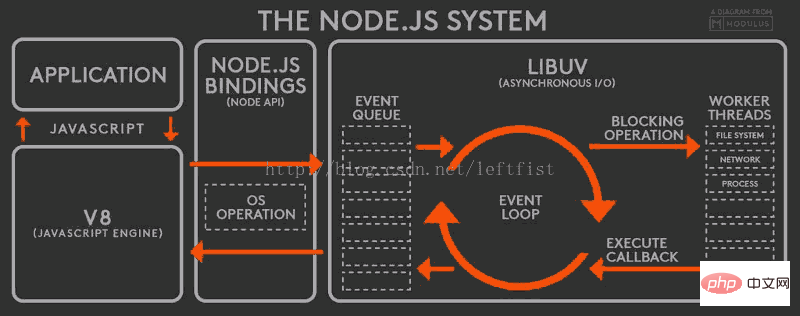What is the asynchronous mechanism of node based on?
The asynchronous mechanism of node is based on "events". All I/O, network communication, and database queries are executed in a non-blocking manner, and the returned results are processed by the event loop. Node will only process one event at the same time, and immediately enter the event loop to check subsequent events after completion. In this way, the CPU and memory can focus on processing one thing at the same time, while trying to allow time-consuming I/O and other operations to be executed in parallel.

The operating environment of this tutorial: Windows 7 system, nodejs version 16, DELL G3 computer.
NodeJS is single-threaded. Single-threading has the following benefits:
Simple
High performance , avoiding the overhead of frequent thread switching
The resource usage is small, because it is a single thread, and the memory usage is still very low under heavy load
-
Thread safety, no locking, unlocking, deadlock problems
How to solve high concurrency?
Node uses asynchronous IO and event-driven (callback function) to solve the problem of high concurrency.
Generally speaking, high concurrency solutions will provide a multi-threading model, providing a thread for each business logic, and making up for the time overhead of synchronous I/O calls through system thread switching. Like apache, there is one thread per request.
NodeJS uses a single-threaded model and uses asynchronous request methods for all I/O to avoid frequent context switching. It maintains an event queue when NodeJS is executed; the program enters the event during execution. The loop waits for the next event to arrive. After each asynchronous I/O request is completed, it will be pushed to the event queue for waiting execution.
The asynchronous mechanism of NodeJS is based on events. All I/O, network communication, and database queries are executed in a non-blocking manner, and the returned results are processed by the event loop. As shown in the figure:

The Node.js process will only process one event at the same time. After completion, it will immediately enter the event loop to check subsequent events. The advantage of this is that the CPU and memory can focus on processing one thing at the same time, while trying to allow time-consuming I/O and other operations to be executed in parallel. For low-speed connection attacks, Node.js only adds requests to the event queue and waits for the operating system's response. Therefore, there is no multi-threading overhead, which can greatly improve the robustness of web applications and prevent malicious attacks.
Event loop mechanism
The so-called event loop means that NodeJS will use the event mechanism to solve all asynchronous operations, and there is a thread that continuously loops to detect the event queue.
All logic in NodeJS is the callback function of the event, so NodeJS is always in the event loop, and the program entry is the callback function of the first event in the event loop. The event callback function may issue an I/O request or directly emit the event, and return to the event loop after execution. The event loop checks the event queue for unhandled events until the program ends. The event loop of NodeJS is invisible to developers and is implemented by the libev library. libev constantly checks whether there are active event listeners that can be detected, and does not exit the event loop until no event listeners are detected, and the program ends.

For more node-related knowledge, please visit: nodejs tutorial!
The above is the detailed content of What is the asynchronous mechanism of node based on?. For more information, please follow other related articles on the PHP Chinese website!

Hot AI Tools

Undresser.AI Undress
AI-powered app for creating realistic nude photos

AI Clothes Remover
Online AI tool for removing clothes from photos.

Undress AI Tool
Undress images for free

Clothoff.io
AI clothes remover

Video Face Swap
Swap faces in any video effortlessly with our completely free AI face swap tool!

Hot Article

Hot Tools

Notepad++7.3.1
Easy-to-use and free code editor

SublimeText3 Chinese version
Chinese version, very easy to use

Zend Studio 13.0.1
Powerful PHP integrated development environment

Dreamweaver CS6
Visual web development tools

SublimeText3 Mac version
God-level code editing software (SublimeText3)

Hot Topics
 1389
1389
 52
52
 How to use express to handle file upload in node project
Mar 28, 2023 pm 07:28 PM
How to use express to handle file upload in node project
Mar 28, 2023 pm 07:28 PM
How to handle file upload? The following article will introduce to you how to use express to handle file uploads in the node project. I hope it will be helpful to you!
 How to delete node in nvm
Dec 29, 2022 am 10:07 AM
How to delete node in nvm
Dec 29, 2022 am 10:07 AM
How to delete node with nvm: 1. Download "nvm-setup.zip" and install it on the C drive; 2. Configure environment variables and check the version number through the "nvm -v" command; 3. Use the "nvm install" command Install node; 4. Delete the installed node through the "nvm uninstall" command.
 An in-depth analysis of Node's process management tool 'pm2”
Apr 03, 2023 pm 06:02 PM
An in-depth analysis of Node's process management tool 'pm2”
Apr 03, 2023 pm 06:02 PM
This article will share with you Node's process management tool "pm2", and talk about why pm2 is needed, how to install and use pm2, I hope it will be helpful to everyone!
 Pi Node Teaching: What is a Pi Node? How to install and set up Pi Node?
Mar 05, 2025 pm 05:57 PM
Pi Node Teaching: What is a Pi Node? How to install and set up Pi Node?
Mar 05, 2025 pm 05:57 PM
Detailed explanation and installation guide for PiNetwork nodes This article will introduce the PiNetwork ecosystem in detail - Pi nodes, a key role in the PiNetwork ecosystem, and provide complete steps for installation and configuration. After the launch of the PiNetwork blockchain test network, Pi nodes have become an important part of many pioneers actively participating in the testing, preparing for the upcoming main network release. If you don’t know PiNetwork yet, please refer to what is Picoin? What is the price for listing? Pi usage, mining and security analysis. What is PiNetwork? The PiNetwork project started in 2019 and owns its exclusive cryptocurrency Pi Coin. The project aims to create a one that everyone can participate
 Let's talk about how to use pkg to package Node.js projects into executable files.
Dec 02, 2022 pm 09:06 PM
Let's talk about how to use pkg to package Node.js projects into executable files.
Dec 02, 2022 pm 09:06 PM
How to package nodejs executable file with pkg? The following article will introduce to you how to use pkg to package a Node project into an executable file. I hope it will be helpful to you!
 What to do if npm node gyp fails
Dec 29, 2022 pm 02:42 PM
What to do if npm node gyp fails
Dec 29, 2022 pm 02:42 PM
npm node gyp fails because "node-gyp.js" does not match the version of "Node.js". The solution is: 1. Clear the node cache through "npm cache clean -f"; 2. Through "npm install -g n" Install the n module; 3. Install the "node v12.21.0" version through the "n v12.21.0" command.
 Token-based authentication with Angular and Node
Sep 01, 2023 pm 02:01 PM
Token-based authentication with Angular and Node
Sep 01, 2023 pm 02:01 PM
Authentication is one of the most important parts of any web application. This tutorial discusses token-based authentication systems and how they differ from traditional login systems. By the end of this tutorial, you will see a fully working demo written in Angular and Node.js. Traditional Authentication Systems Before moving on to token-based authentication systems, let’s take a look at traditional authentication systems. The user provides their username and password in the login form and clicks Login. After making the request, authenticate the user on the backend by querying the database. If the request is valid, a session is created using the user information obtained from the database, and the session information is returned in the response header so that the session ID is stored in the browser. Provides access to applications subject to
 A brief analysis of how node implements ocr
Oct 31, 2022 pm 07:09 PM
A brief analysis of how node implements ocr
Oct 31, 2022 pm 07:09 PM
How to implement OCR (optical character recognition)? The following article will introduce to you how to use node to implement OCR. I hope it will be helpful to you!




